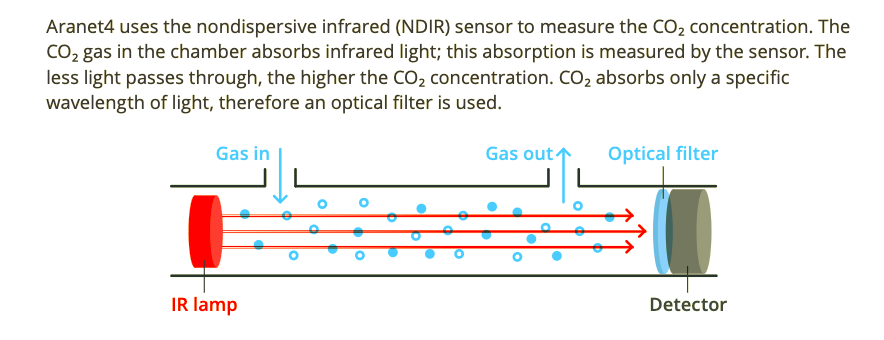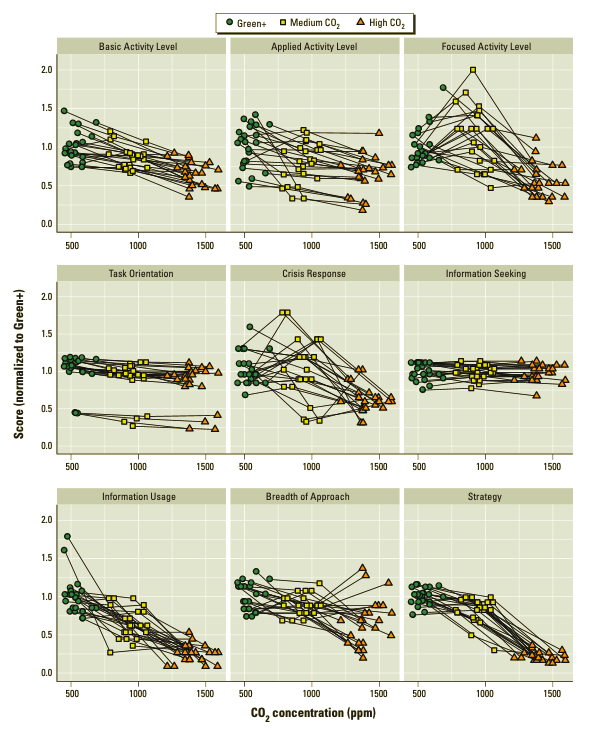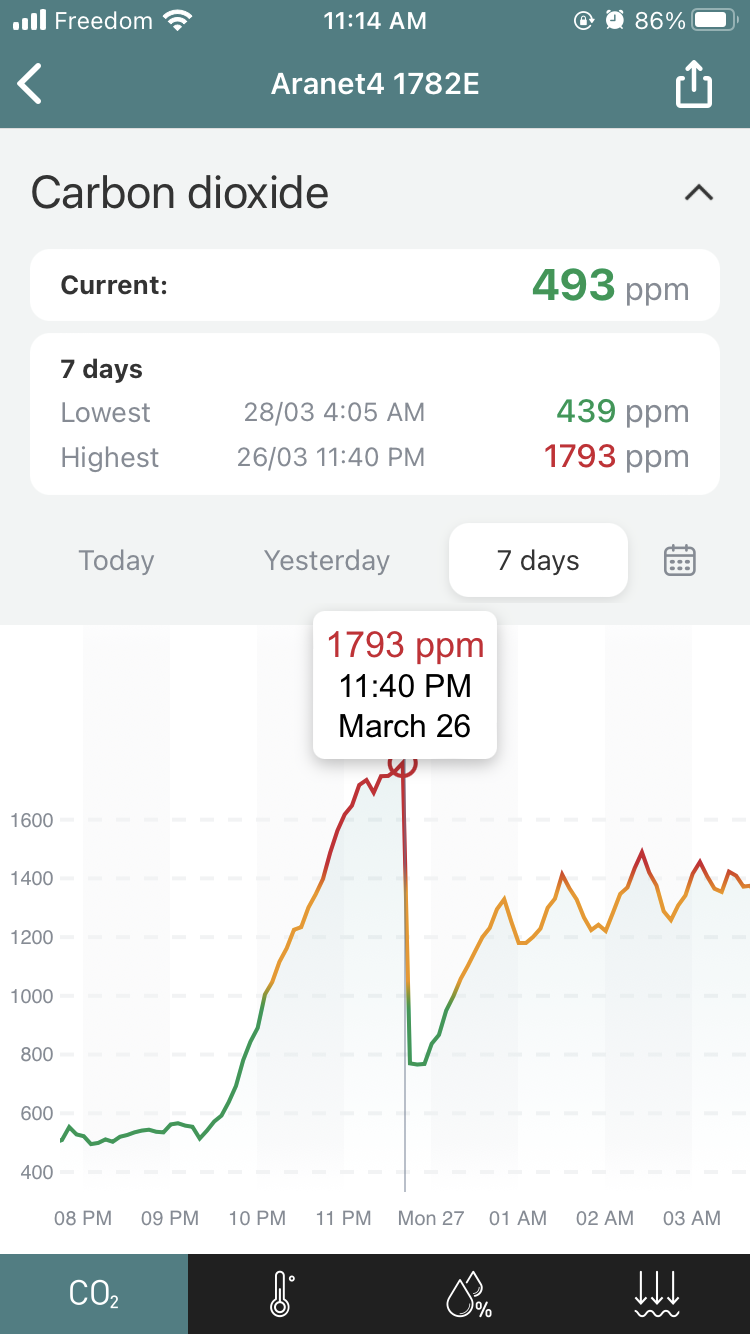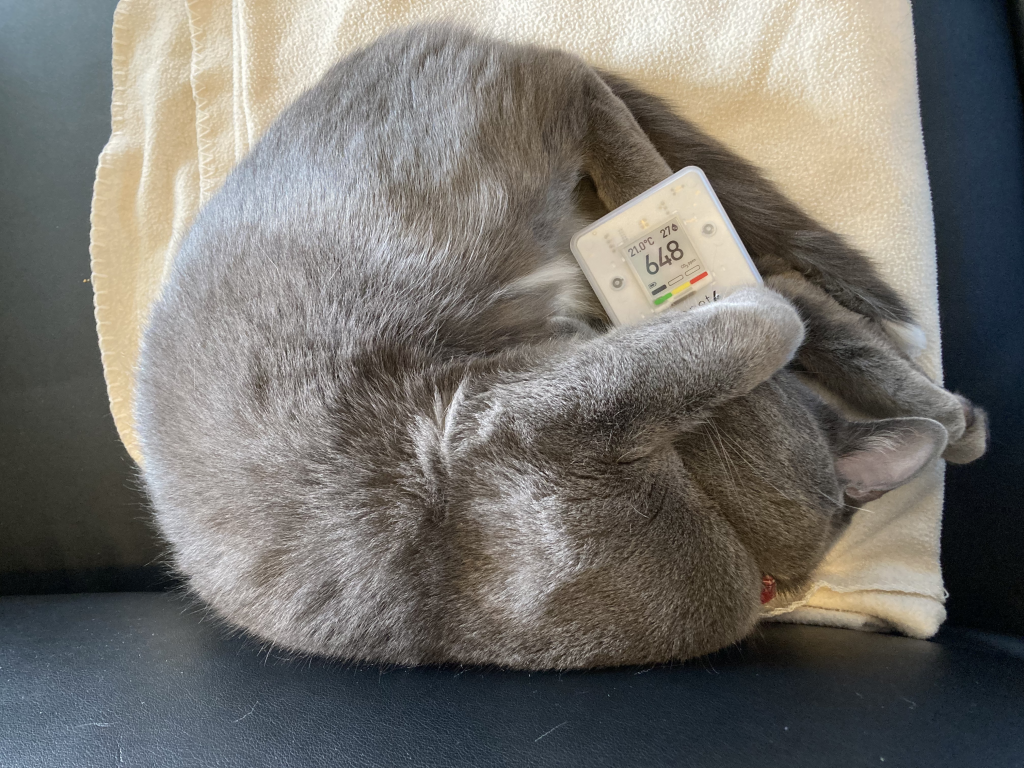I recently bought an aranet 4 from Canadian Tire, of all places. Here’s my review.
TL;DR: It’s calibrated, convenient, and easy to use, and your indoor CO2 readings may surprise you.
What is it for?
The Aranet 4 monitors CO2, temperature, and humidity. It uses a non-dispersive infrared sensor (NDIR) to measure the ambient CO2 in parts per million (ppm). From the user manual:

Why does that matter?
1. Thinking:
The outdoor CO2 concentration is around 400-450 ppm (for now…). Inside, with the windows closed, CO2 concentrations can rise rapidly, and high CO2 concentrations actually affect our activity levels and cognition, especially in the domains of information usage and strategy. From a study of office workers exposed to low, medium, and high CO2 concentrations (doi:10.1289/ehp.1510037):

Many countries, including Canada, have issued guidelines in the 600-1000ppm range for indoor CO2 concentrations, and ASHRAE (American Society of Heating, Refrigerating and Air-Conditioning Engineers) recommends keeping indoor CO2 levels to no more than 700 ppm above outdoor levels (so, 1100-1200 ppm).[source]
2. Health:
CO2 concentrations can be used as a rough proxy for clean air. Many illnesses spread through the air, either through droplet or aerosol spread. If indoor CO2 concentrations are low, despite everyone in the room busily metabolizing and breathing out CO2, that means there’s excellent ventilation, and therefore a much lower chance that the air you breathe in has been breathed (or sneezed!) out by somebody else. However, if CO2 concentrations are high, that doesn’t necessarily mean the air isn’t clean. A HEPA filter will remove bacteria, viruses and dust from the air, but will not lower the CO2. So, the higher the indoor CO2 concentration, the more important it is to make sure those HEPA filters are on.
Canadian Tire? Seriously?
Yes! Canadian Tire’s goods mostly range from dollar-store quality to “decent, but far from the best,” so it was a huge surprise to find an Aranet 4 for sale there for less than it would cost to buy it direct & pay for shipping. I bought one online and picked it up the next day.
The review
1. It works
Insert batteries, bam! it boots and works. Very easy setup. It even ships with two batteries.
One caveat: the first reading I got after putting the batteries in was whack, over 1000ppm higher than subsequent readings.
2. It’s properly calibrated straight from the factory
I checked the calibration on the Aranet 4 by taking it outside. I got a CO2 reading of 445 ppm, which is both in the expected range and accords with the 440ppm I got earlier with another CO2 sensor.
3. Setup with the phone app was easy
The bad news: Although a 7-day history of CO2, temp and humidity readings is stored on the sensor, you need the app to actually see that history, and to configure basic functionality like the monitoring interval, temperature scale (C or F), and buzzer (audio alert if CO2 goes over 1500ppm).
The good news: App setup is easy. Install phone app, make sure Bluetooth is on, pair with Aranet 4 in the app, done.
4. Monitoring interval
The default interval between readings is 5 minutes, which is fine for sitting around, but annoying when you’re trying to test it. The only way to reset the monitoring interval is through the app. Options are every 1, 2, 5 or 10 minutes.
5. Leave that bedroom door cracked!
We settled down in a small room with the door closed to watch a movie. I left the Aranet on, and checked the graph at the end. Between 9:30 and 11:30, CO2 rose from 550 ppm to almost 1800 ppm — enough to affect our cognitive function.

Then, I brought the Aranet into the bedroom, but left the door cracked open an inch. Between 11:45 pm and 2:30 am, CO2 rose to 1489 ppm, with a few marked peaks and valleys, then sawtoothed back down to 1284 ppm at 7:30 am. I’m guessing that the peaks and valleys have something to do with the forced-air heat going on and off.

6. CO2 readings are fast, temp readings are slow
Taking the Aranet4 from one room to a different one, or from inside to outside, shows up immediately in the CO2 readings. The temperature and humidity readings are slower to update. For example, when I brought the Aranet4 from my 20-degree (Celsius) house to the 5-degree outside, the CO2 reading immediately showed 445 ppm, but the temp reading was 12 degrees. So, don’t expect instant-read-thermometer speed from the Aranet 4.
7. Mysterious firmware update
The Aranet 4 shipped with firmware version v1.1.2, which was out of date when I got it. There was zero indication that it was out of date, unfortunately. In “Device Settings”, if I clicked on the firmware version (which wasn’t flagged in any way), only then I would find out that a more recent version was available.
Eventually, I stumbled across this and decided to update the firmware to the current version, 1.2.1. This was as simple as putting my phone next to the Aranet, clicking “Upgrade[sic] firmware”, and not touching anything until it was done. No release notes seem to be available anywhere, so I have no idea if any bugs were fixed or why the update was released. All I’ve got is that it still seems to work post update.
8. Personal vs. pro
The Aranet 4 comes in two versions which are visually indistinguishable: Personal and Pro. The Canadian Tire website doesn’t say which one I got, but I’m reasonably sure it’s the personal one. The only difference seems to be that the “pro” version can connect to a (separately available) wireless base station, which can accept connections from multiple Aranet Pros. For home users, the phone app’s ability to connect to up to 6 Aranet Personals is probably more than sufficient.
Verdict so far: Small, portable, easy and convenient
The Aranet 4 is small and simple enough I could take it out to scout CO2 in restaurants, theatres or museums, or send it with my kid to school and then check the day’s CO2 graph when the kid gets home (historical data is stored on the sensor). No major headaches, it’s accurate, and it works. So far, 10/10 would buy again.
Coming soon: side-by-side readings
The next step is to take several side-by-side readings with the aranet4 and another, less portable CO2 sensor, in various areas.
User manual
https://cdn.bfldr.com/FS48XT6B/at/vzp23x5qbsfk7t5t3vp8n/Aranet4_User_Manual_v25_WEB.pdf
